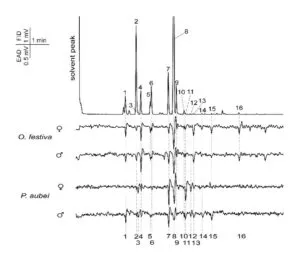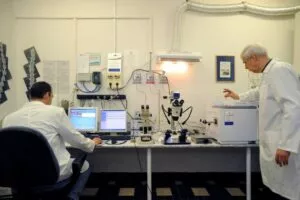Staff from the Zoological Department of the ELKH ATK Plant Protection Institute (NÖVI) have analyzed the components of the odor of the emerald thuja tree and identified odor compounds that attract the harmful cypress jewel beetle and small cypress bark beetle. In the study, the researchers also demonstrated that the two beetle species can detect different odor components. In the future, this discovery will make it possible to use specific odors to develop odor traps that signal when there is a swarm of pests. An article presenting the results of the research has been published in the prestigious journal Physiological Entomology.
The presence of the cypress jewel beetle (Ovalisia festiva) and the cypress bark beetle (Phloeosinus aubei) extends from the Mediterranean to the continental climate of Europe. The two species of beetles use thuja and cypresses as their host plants, mainly in ornamental nurseries and urban green areas. The larvae live obscured inside trees and bore passages in the plants. This initially only causes aesthetic damage but can later destroy trees weakened by drought.

How do they find these trees? What odors help them find their way? How can the components used as markers for beetles be identified and used in selective plant protection? The ATK NÖVI researchers Dr Gábor Bozsik, Dr Péter Béla Molnár and Dr Gábor Szőcs have sought answers to these questions by examining the components perceived by beetles in the odor of emerald thuja (Thuja occidentalis). To do this, the researchers first captured the odor emitted by the thuja using a special activated carbon filter, and then analyzed the organic solvent extract of the scent with a biosensor gas chromatograph.

In the chromatographic separation of the extremely complex odor, the biosensor, i.e. the 'tentacle detector', made it possible to filter out the components detectable by the beetles. From several hundred components, around 18 such components have been identified with the help of this unique instrument.

The hypothesis was confirmed: the researchers were not only able to identify the compounds in question, but also demonstrated that the two beetle species are able to detect different odor components. The study found that components detected by both species are more common, but one notable find was that the two pests 'see' the same host plant differently. This result will be important in the development of specific attractive compounds.
The chemical structure of the key compounds was also determined by mass spectroscopy. The next stage of the research will determine which of these compounds attract pests in the field. This means that the use of certain odors, i.e. cairomones, is planned to develop fragrance traps in the future to indicate the swarming of pests.
Publication:
Bozsik, G., Molnár, B. P. and Szőcs, G. (2022): Comparison of antennal responses of Ovalisia festiva and Phloeosinus aubei to volatile compounds of their common host, Thuja occidentalis. Physiological Entomology DOI: 10.1111/phen.12383.